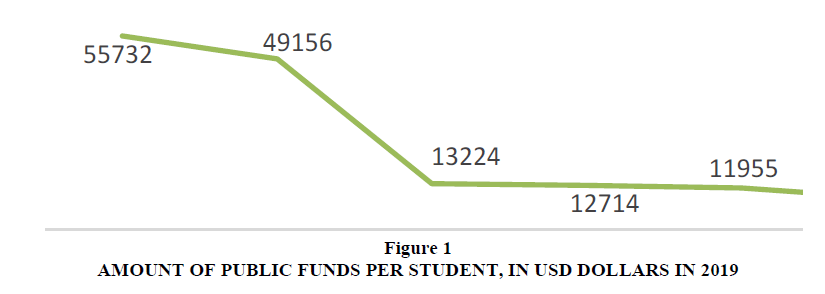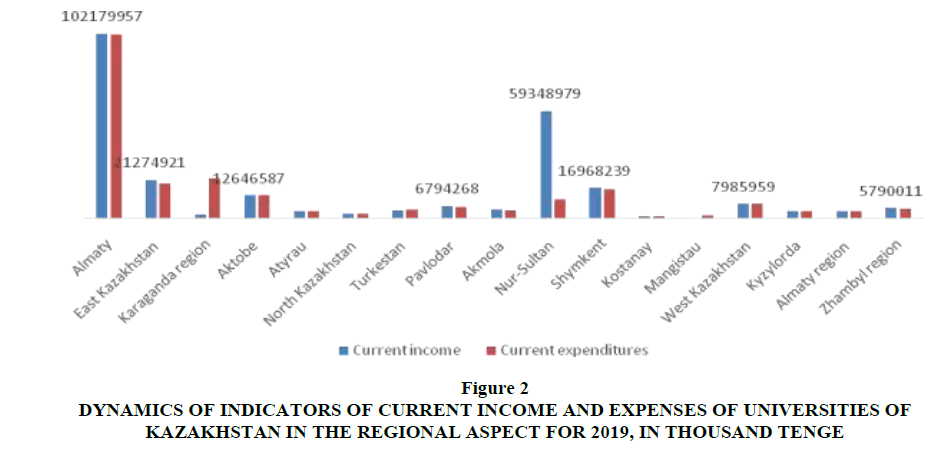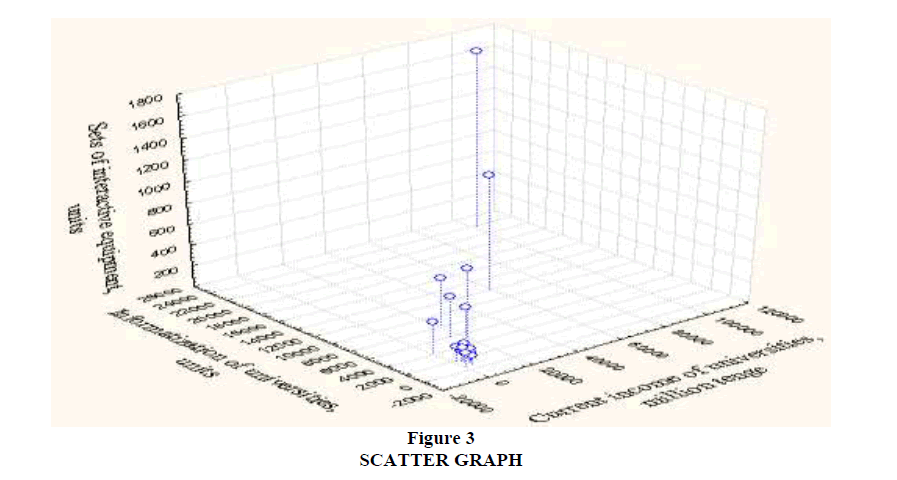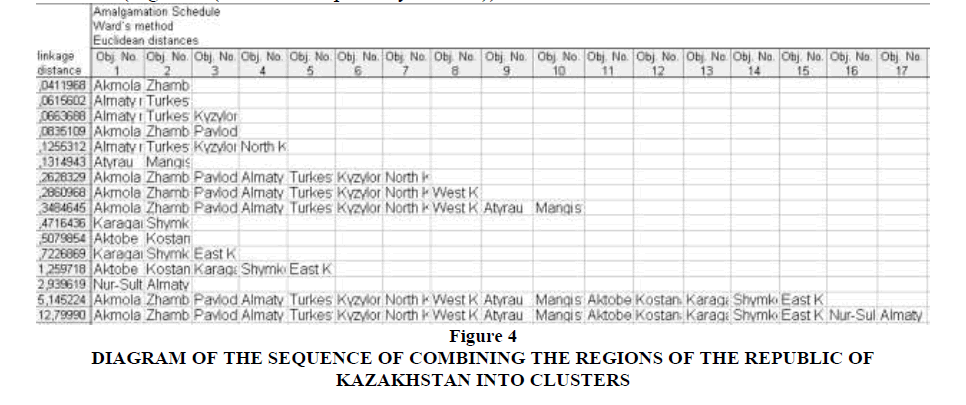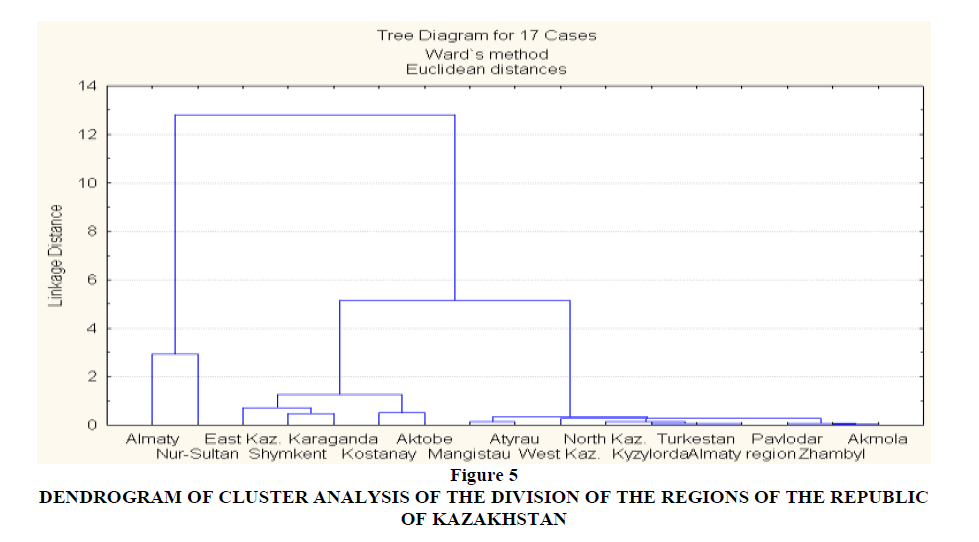Research Article: 2021 Vol: 25 Issue: 4
Analysis of the Transformation of Higher Educational Institutions through Entrepreneurship in the Conditions of Digitalization
Rabiga Zhashkenova, Karaganda Economic University of Kazpotrebsoyuz
Tatyana Pritvorova, Buketov Karagandy University
Lyazat Talimova, Karaganda Economic University of Kazpotrebsoyuz
Saule Mazhitova, Karaganda Economic University of Kazpotrebsoyuz
Aziza Dauletova, Karaganda Economic University of Kazpotrebsoyuz
Aydin Kernebaev, Karaganda Economic University of Kazpotrebsoyuz
Abstract
In the context of the formation of a digital economy in Kazakhstan, it becomes relevant to study the realities and prospects for the development of digital entrepreneurship. In the process of improving national education, modern technologies are acquiring an increasing role every year, the introduction of which contributes to the modernization and development of education, as well as to the improvement the entrepreneurship role of the quality of training of future specialists and the convergence of education with science. At the same time, such technologies require a revision of existing approaches to educational activities, as well as an analysis of their impact on society and individual social groups. A carefully thought-out educational policy that takes into account modern trends will help not only to fill the labor market with specialists in a balanced way, but also to prevent social collapse. The active implementation of cluster policy in the modern digital economy is due to the need to eliminate the shortcomings inherent in the market for educational services of higher educational institutions with the aim of coordinated cluster initiatives and the development of a balanced educational policy in the context of digitalization.
Keywords
Transformation, Entrepreneurship, Higher Education, Digitalization, Business Community, Strategy, Education System, innovation, Educational Process, Management, Quality.
introduction
The rapidly developing digital economy, penetrating all spheres of life in modern society, gives rise to the need for systemic technological breakthroughs and the development of new ways of processing information. The process of total digitalization will inevitably change the structure of employment of the population and the educational environment.
The 21st century is characterized by the transition to a new qualitative state of human activity and society. Humanity has entered a new era - the information era, which is characterized by the development of a market economy, an open and democratic society, the spread of telecommunications, and the internet and computer technologies.
Globally, digitalization is a concept of economic activity based on digital technologies being introduced in various spheres of life and production. and this concept is widely implemented in all countries without exception.
Digitalization has been declared one of the main trends in the development of modern states, which is associated with the emergence of "smart cities" and "smart objects", etc. The modern transformation of higher education is due to the transition from an industrial to a postindustrial structure, which has changed the requirements for the main activities, qualifications and competencies, the transition to digital media and the ability to quickly transmit digital media anywhere in the world via the global internet, which has changed the educational space. It is no coincidence that this was due to a number of global processes, including changes in the structure of processes, forms of organization and the use of pedagogical technologies in the system of higher educational institutions.
The world of education and science has become global, now it is almost impossible to find a student, teacher or scientist who has not visited foreign universities as part of academic mobility programs. in the course of unprecedented changes, many universities are trying to adapt and find their place on the global scientific and educational map, while maintaining their unique qualities and competitive advantages.
Modern digital technologies provide new tools for the development of universities and other educational institutions around the world. Digitalization provides opportunities for the exchange of accumulated experience and knowledge, which allows people to learn more and make better decisions in their daily lives. Carefully thought-out educational policies that take into account modern trends will help not only fill the labor market in a balanced way, but also prevent social collapse.
Educational organizations act as elements of the national and regional innovation system, which are designed to produce new knowledge, its widespread dissemination and use, which contributes to the financial, economic, legal and information support of innovative processes in the regions of the country. To create sustainable innovation systems, it is necessary to have developed research institutions, attract highly qualified personnel, provide conditions for supporting innovation and technology, as well as an active position of the government sector and a stable legislative framework.
Assessment of the level of digitalization of educational organizations allows us to identify the strengths and weaknesses of this process and justify the necessary management decisions that can provide the prerequisites for the innovative development of the national economy on a digital basis.
Modern digital technologies provide new tools for the development of universities and other educational institutions around the world. Digitization provides an opportunity to exchange accumulated experience and knowledge, allowing people to learn more and make better decisions in everyday life.
Research Background
At the moment, researchers analyzing the digitalization trends in higher education focus on the digital literacy of the population, on the impact of information and communication technologies, on the level of digitalization of education in general, and on legal barriers that prevent transformation.
University digitalization is a complex, continuous process that depends on many factors associated with organizational changes, functioning in strict accordance with the social role of universities in the provision of services (Zajkowski & Stańczak 2015).
in connection with the accelerated rate of development of information and communication technologies, digital society and the digital economy give rise to certain skills and competencies that are essential for achieving professional success or personal development of a person (Bejinaru, 2019).
innovation, as a result of interconnected processes of learning and knowledge creation, is a special way with which economic agents "adapt" to constantly changing conditions. These new economic demands are putting increasing pressure on universities and generating major changes in their governance. in this sense, Lupan & Bejinaru. (2019) believes that academic management should be directed in such a way as to improve the relationship between intellectual capital and performance management. Universities focused on entrepreneurship, technological development and scientific research have a strong impact on the economic environment.
Due to the study of the entrepreneurial model in the context of the transformation of universities, policies and governance mechanisms in the field of higher education, according to Toan Van Dinh (2020), should be improved in such a way as to create an ecological environment conducive to innovation in the digital economy, and to form an advanced university management.
According to Dunaeva (2016), information technologies in education are radically changing the traditional system of higher education, since they are focused on the effective integrated use of virtual resources, are designed for an online audience, video broadcasts and an individually oriented approach, as the main principle of organizing education instead of a group approach.
in his research, Feng Gao (2020) argues that in the era of big data, the development of information management in the higher education system has led to some changes, as a result of which a new concept of building an educational information management model has been proposed, including strengthening the building of a system of information management standards in education management, promoting effective integration of the education management system, improvement of education administrators, believing that general information literacy contributes to the creation of information in the field of education management and the creation on its basis of a new learning model.
Starting in the spring of 2020, the outbreak of COVID-19 has forced all universities in the world to close campuses (dormitories) and start online learning. Due to these circumstances, the main focus in all universities is on online education, which, according to Wei Bao (2020), is represented by specific teaching strategies to summarize the current online learning experience for university teachers who could conduct online education:
- high relevance between online instructional design and student learning;
- efficient delivery of online training information;
- adequate support provided by teachers and teaching assistants to students;
- high quality participation to enhance the breadth and depth of student learning;
- a contingency plan for online education platforms.
Considering foreign experience, despite the fact that before the outbreak of Covid-19, the level of adoption of e-learning aids decreased slightly, it can be assumed that the demand for digital offers will rather increase. Therefore, it can be assumed that the current situation will have a positive impact on digital innovation in teaching in higher education due to the pressure of the crisis, the great dedication of many teachers and heightened expectations.
According to research by Olaf Zawacki-Richter (2020) in Germany, during all three years of the survey (2012, 2015, 2018), more than 99% of students stated that they have access to the internet at home. If in 2012 only slightly more than half had a smart phone with mobile internet access, then in 2018 this figure was 98%. Students estimate that they use the internet for an average of four hours a day. Overall, students are very well equipped with digital devices. On average, they have five different endpoints. While stationary devices (desktops, printers, scanners) have become less and less important over the years, mobile devices have become more and more popular (smart phones + 42% or tablet computers + 34%) (Table 1).
| Table 1 Indicators of the Use of Internet Technologies Abroad |
||||
| Usage mode | 2012 | 2015 | 2018 | Δ (2018–2012) |
|---|---|---|---|---|
| Library service | 28% | 45% | 53% | 25% |
| Collecting data for exam papers | 24% | 35% | 48% | 24% |
| Research for exam papers and presentations | 45% | 55% | 69% | 23% |
| Sending emails to teachers | 51% | 65% | 74% | 23% |
| Classes on courses | 39% | 46% | 57% | 18% |
| Review scores | 55% | 66% | 69% | 14% |
| Take pictures | 66% | 70% | 78% | 12% |
| Writing texts for exam papers | 6% | 11% | 18% | 12% |
| Buying books | 24% | 30% | 35% | 11% |
| Access to Learning Management Systems | 68% | 75% | 78% | 10% |
| internet research during lesson | 71% | 71% | 74% | 4% |
| Sending texts or photos | 41% | 41% | 45% | 4% |
| Sending letters to fellow students | 70% | 72% | 73% | 3% |
| LMS communication | 36% | 41% | 38% | 3% |
| Sending SMS messages to fellow students | 84% | 61% | 36% | −48% |
| Instant messaging (e.g. WhatsApp). | - | - | 88% | |
Source: compiled by authors according to Olaf Zawacki‐Richter (2020)
According to research by Minina (2020) on the topic of digitalization of higher education identified four trends associated with the introduction of digital technologies and tools into the educational process:
- formation of a blended learning model;
- transition to online learning;
- creation of a virtual (digital) educational environment;
- changing the approach to the management of educational organizations.
These trends are interrelated, but each has a specific impact on higher education institutions. On the one hand, digitization increases the openness and flexibility of education, increases student involvement in the educational process and develops a network model of university interaction. On the other hand, this leads to the emergence of new educational situations and changes the composition of relations between the main participants by introducing new factors into the education system.
Digitization leads to significant changes in the role of teachers and students in the learning process, which require appropriate adaptation.
According to scientists such as Echenique et al. (2015), the transition to online education and the creation of a virtual educational environment create the need for a change in the management of educational organizations. and if these changes do not occur, digitalization can have negative consequences.
So, characterizing the experience of digitalization of education, J. Cross (2018) noted: “We thought that we could take teachers out of the educational process and let students act independently. We were wrong. The first generation of e-learning systems ended in failure”. Determining the positive potential of digitalization, we note that digital technologies offer many options in the design of educational processes. At the same time, the educational space formed by digitalization has the features of universality.
According to the researcher, the creation of a virtual learning environment radically changes the role of the teacher in higher education. He or she becomes a kind of teaching technician who develops an effective and engaging learning environment that shapes learners' lifelong learning abilities (Saykili, 2019).
For example, Tulinayo et al. (2018) used an internet technology called TAM (Technology Adoption Model) at the College of Computing and information. Blended learning model in science (Uganda).
Modern digital technologies, according to research, have made it possible to create a personalized learning environment that combines formal and non-formal learning. Social networks play a central role in the formation of a personalized learning environment as a set of various network tools and technologies that serve as channels of communication, cooperation and creative expression (Dabbagh & Kitsantas 2012).
Experts view the following media as social networks that are actively used in education:
- weblogs, or easily created blogs, and updated sites that allow authors to publish immediately on the internet (they facilitate communication between teachers and students);
- wikis, where members can use their web browsers to modify any page or create a new one - a web browser on which users can create new pages or add and edit already published ones;
- websites on which users can create new pages or add and edit already published;
- bookmarking sites that allow users to bookmark and exchange links to sites (users can create personalized websites, examples: Reddit, StumbleUpon, Digg);
- social networking sites (Youtube, Facebook, Linkedin, VKontakte, etc.) is a publicly available web service that allows users to create a personal profile, identify other users with whom they are associated, read and respond to messages from other users on the site, and also send and receive private and public messages.
According to Peshkova & Samarina (2018), the rapidly developing digital economy, penetrating into all spheres of life in modern society, gives rise to the need for systemic technological breakthroughs and the development of new methods of information processing.
Universities around the world are increasingly digitizing all of their operations, with the current COVID-19 pandemic accelerating other sustainable change (Laksov & McGrath, 2020).
Universities are faced with management problems associated with the ability to research and use their activities to achieve social, innovative and economic results, as evidenced by the results of foreign researchers Cruz-Amarán et al. (2020).
Research by Lattu & Cai (2020) provides insight into the analytical framework developed by Hann et al. (2015) for understanding the corporate sustainability controversy in the context of the university system in order to identify areas related to stability of universities.
Methodology
The study was carried out using methods such as: abstract - logical and comparative analysis, also used a descriptive method and generalization, as well as methods of system analysis, economic comparison, expert assessments. in the course of the research, the author analyzed the classification of the universities in Kazakhstan using cluster analysis, which allows the division of objects into homogeneous groups or clusters according to a number of features in the regional aspect. To solve the problem, the usual Euclidean metric was used, and the distance between the clusters was determined by the Ward's method. Due to the fact that the indicators are presented in different units of measurement, the initial data were previously normalized. As a result, a sequence diagram was obtained for the unification of clusters in the regional aspect of universities in Kazakhstan.
Analysis and Results
The role of innovative higher education in the context of digitalization and its contribution to the country's economy is the main lever of economic growth and is critically important in the context of digitalization and innovation policy of the state.
But still, comparing the indicators of foreign countries in relation to the share of government spending on education in total GDP, Kazakhstan has the least value in this comparison ((Figure 1 (Source: compiled by authors according to https://www.statista.com)).
To divide objects into homogeneous groups according to the indicators under consideration (current income and expenses of universities, informatization of universities and the use of interactive equipment), we will conduct a cluster analysis, which allows this analysis to be carried out (Table 2).
| Table 2 Indicators Characterizing the Level of Digitalization of Higher Educational Institutions in the Regional Branch in 2019 |
|||||
| Region | Current income of universities, thousand tenge | Operating expenses of universities, thousand tenge | Informatization of universities (number of computers in the educational process), | Number of sets of interactive equipment, units | Number of higher educational institutions, units |
|---|---|---|---|---|---|
| units | |||||
| Akmola | 4991612 | 4188123 | 1254 | 106 | 4 |
| Atuibinsk | 12646587 | 12691431 | 3479 | 396 | 6 |
| Almaty | 3720247 | 3688648 | 1736 | 98 | 3 |
| Atyrau | 4111522 | 3766161 | 723 | 88 | 3 |
| West Kazakhstan | 7985959 | 7733956 | 2398 | 121 | 4 |
| Zhambyl | 5790011 | 5189904 | 1249 | 94 | 3 |
| Karaganda | 22066404 | 22015733 | 8402 | 449 | 9 |
| Kostanay | 1143753 | 1143753 | 4209 | 300 | 7 |
| Kyzylorda | 3740170 | 3652757 | 1459 | 116 | 3 |
| Mangistau | 1511593 | 1432108 | 792 | 125 | 2 |
| Pavlodar | 6794268 | 6157978 | 1479 | 110 | 4 |
| North Kazakhstan | 2307940 | 2298076 | 1896 | 141 | 2 |
| Turkestan | 4320323 | 4663082 | 1819 | 122 | 2 |
| East Kazakhstan | 21274921 | 19305304 | 5416 | 643 | 7 |
| Nur-Sultan city | 59348979 | 100931875 | 12063 | 1090 | 15 |
| Almaty city | 102179957 | 101831140 | 23768 | 1690 | 41 |
| Shymkent city | 16968239 | 15767028 | 6081 | 380 | 10 |
| Total: | 285192910 | 320683745 | 78223 | 6069 | 125 |
Source: compiled by authors according to the source Committee on Statistics of the Ministry of National Economy of the Republic of Kazakhstan
According to the data presented in Table 2, in 2019 we can observe a pronounced trend in the development of income and expenditure current indicators of universities in Kazakhstan in Aktobe, Karaganda regions, Nur-Sultan, Almaty, Shymkent (Figure 2 (Source: compiled by authors according to the source Committee on Statistics of the Ministry of National Economy of the Republic of Kazakhstan)).
Figure 2: Dynamics of indicators of Current Income and Expenses of Universities of Kazakhstan in The Regional Aspect for 2019, in Thousand Tenge
Based on the data on the income of universities and the degree of their informatization, we will classify the regions of the Republic of Kazakhstan. Let us graphically represent the relationship between the indicators under consideration using a scatter plot (Figure 3 (Source: compiled by authors)).
Current income of universities, million tengevs. The number of sets of interactive equipment, unitsvs. informatization of universities (number of computers in the educational process), units.
To classify the regions, cluster analysis was used, which allows the division of objects into homogeneous groups according to the indicators under consideration. Objects are considered homogeneous if the observed features are in close proximity to each other. The proximity metric is the distance metric. To solve this problem, the usual Euclidean metric was used, and the distance between the clusters was determined by the Ward's method.
Due to the fact that the indicators are presented in different units of measurement, the initial data were previously normalized. As a result, a diagram of the sequence of combining clusters was obtained (Figure 4 (Source: compiled by authors)).
Figure 4: Diagram of The Sequence of Combining The Regions of The Republic of Kazakhstan into Clusters
The results of the cluster analysis can be presented in the form of a dendrogram (Figure 5 (Source: compiled by authors)).
Figure 5: Dendrogram of Cluster Analysis of The Division of The Regions of The Republic of Kazakhstan
Thus, the regions of Kazakhstan in terms of the profitability of universities and the degree of their informatization can be divided into the following clusters:
Cluster 1 - Almaty, Nur-Sultan.
Cluster 2 - East Kazakhstan region, Shymkent, Karaganda, Kostanay, Aktobe.
Cluster 3 - Mangistau, Atyrau, WKO, NKO, Kyzylorda, Turkestan, Almaty, Pavlodar, Zhambyl, Akmola.
Conclusion
To classify the regions, the author used cluster analysis, which allows dividing objects into homogeneous groups according to the indicators under consideration (current income and expenses of universities, informatization of universities and the use of interactive equipment). As a result of the cluster analysis, the author identified clusters in terms of profitability indicators of universities and the degree of their informatization:
- Cluster 1 - Almaty, Nur-Sultan.
- Cluster 2 - East Kazakhstan region, Shymkent, Karaganda, Kostanay, Aktobe.
- Cluster 3 - Mangistau, Atyrau, WKO, NKO, Kyzylorda, Turkestan, Almaty, Pavlodar, Zhambyl, Akmola.
- to develop and strengthen the philosophy and values of the educational activities of the university;
- to improve the system of promoting the image at the regional and international level;
- to unite the efforts of the structural services of the university to create a positive image of the university and find the most effective ways to promote it using modern information technologies;
- to improve the corporate culture of the university and consolidating the team;
- to use of the information potential (resources) of the university using modern means of communication.
References
- Bao, W. (2020) COVID‐19 and online teaching in higher education: A case study of Peking University. Human Behavior Emerging Technologies, 2(2), 113–115.
- Bejinaru, R. (2019) Impact of digitalization on education in the knowledge economy. Management Dynamics in the Knowledge Economy, 3(7), 367-380.
- Bolander, K., & McGrath, C. (2020) Failure as a catalyst for learning: Towards deliberate reflection in academic development work. international Journal for Academic Development, 1(25), 1–4.
- Cross, J. (2018). An informal history of eLearning. Universities and Knowledge Society Journal, 15(3), 7-15.
- Cruz-Amarán, D., Guerrero, М., & Hernández-Ruiz, А. (2020). Changing times at cuban universities: looking into the transition towards a social, entrepreneurial and innovative organization Sustainability, 12(6), 2536 - 2547.
- Dabbagh, N., Kitsantas, A. (2012) Personal Learning Environments, social media, and self-regulated learning: A natural formula for connecting formal and informal learning. internet and Higher Education, 7(15), 3–8.
- Dinh T. (2020). Academic entrepreneurialism and the entrepreneurial university model and policy implication for Vietnam. Economics and Business, 4(36), 108-123.
- Echenique, E., Molías L., & Bullen M. (2015) Students in higher education: Social and academic uses of digital technology. Universities and Knowledge Society Journal, 12(1), 1–11.
- Feng, G. (2020). Development of informatization innovation of university education management under the era of big data. innovative Computing, IC 2020, 45(675),1343-1350.
- Lattu , А., & Cai , Y. (2020). Tensions in the sustainability of higher education-the case of finnish universities . Sustainability, 12(5), 1941-1952.
- Lupan, M., &Bejinaru, R. (2019). Perspectives of university governance for the development of entrepreneurship. The USV Annals of Economics and Public Administration, 19(29), 74-81.
- Minina, V. (2020) Digitalization of higher education and its social outcomes. Bulletin of Saint Petersburg University, 1(13), 84–101.
- Peshkova, G., & Samarina, А. (2018) Digital economy and recruitment potential: strategical interconnection and prospects. The Education and science journal, 20(10), 50-75.
- Saykili, A. (2019) Higher education in the digital age: The impact of digital connective technologies. Journal of Educational Technology & Online Learning, 2(1), 1–15.
- Tulinayo, F., Ssentume, P., & Najjuma, R. (2018) Digital technologies in resource constrained higher institutions of learning: a study on students’ acceptance and usability. international Journal of Educational Technology in Higher Education, 15(36), 1–19.
- Unaeva, Y.U. (2016). information technologies of education as tools of university education. Labor Economics, 2(11), 103-111.
- Zajkowski, A., & Stańczak, J. (2015). The challenges of public university informatization. Foundations of Management, 7(11), 239-252.
- Zawacki‐Richter, O. (2020) The current state and impact of Covid‐19 on digital higher education in Germany. Human Behavior and Emerging Technologies, 7(11), 785-796.
